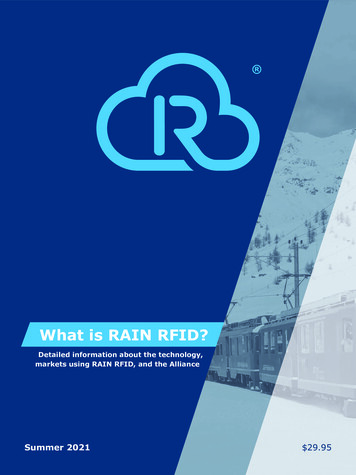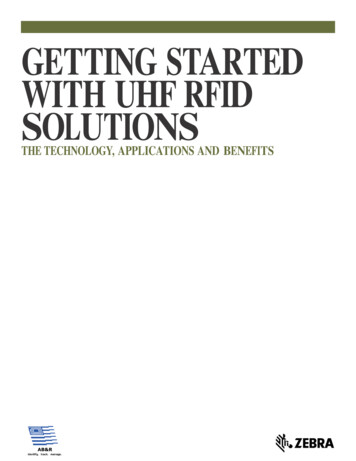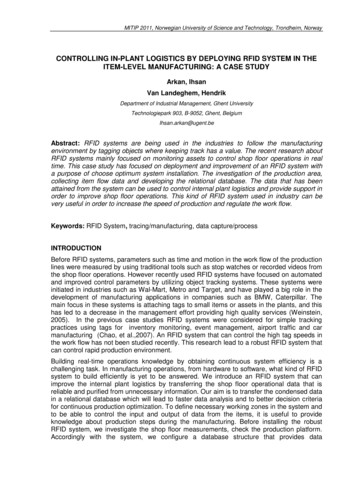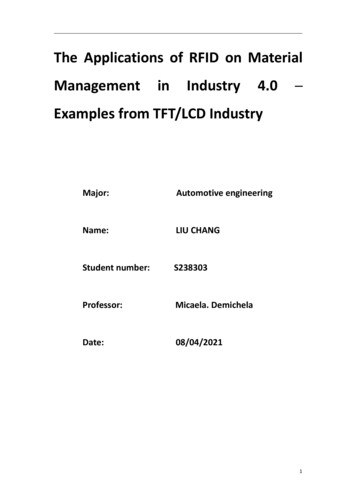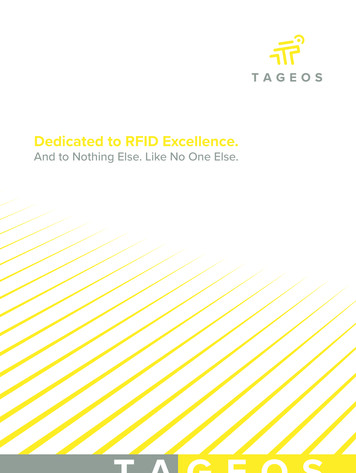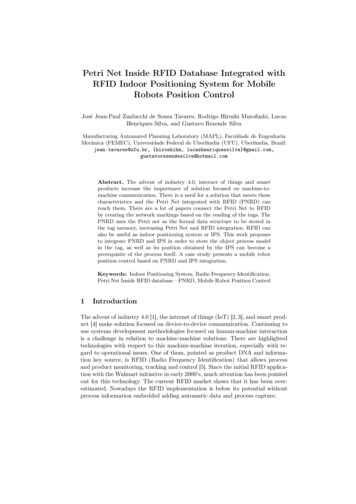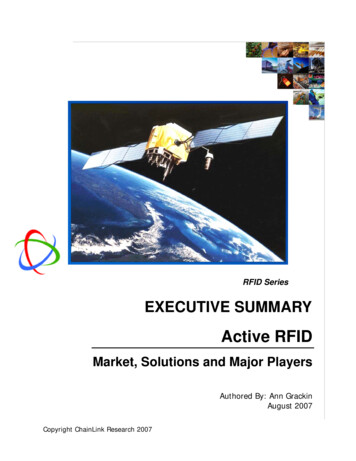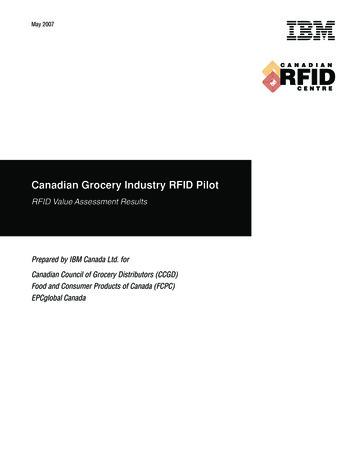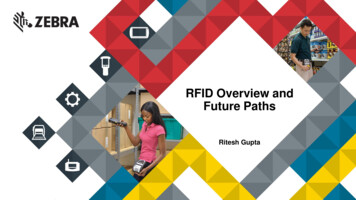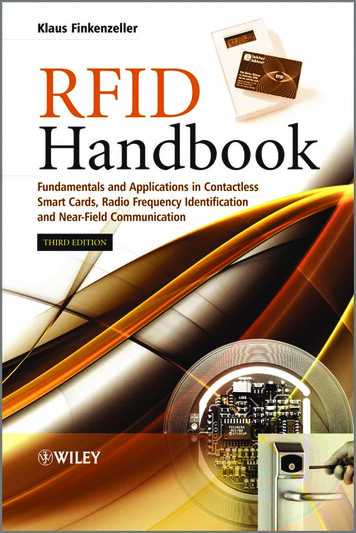
Transcription
RFID HANDBOOKTHIRD EDITION
RFID HANDBOOKFUNDAMENTALS ANDAPPLICATIONS IN CONTACTLESSSMART CARDS, RADIO FREQUENCYIDENTIFICATION AND NEAR-FIELDCOMMUNICATION, THIRD EDITIONKlaus FinkenzellerGiesecke & Devrient GmbH, Munich, GermanyTranslated by Dörte MüllerPowerwording.comA John Wiley and Sons, Ltd., Publication
This edition first published 2010 2010, John Wiley & Sons, Ltd.Registered officeJohn Wiley & Sons Ltd, The Atrium, Southern Gate, Chichester, West Sussex, PO19 8SQ, United KingdomFor details of our global editorial offices, for customer services and for information about how to apply for permission toreuse the copyright material in this book please see our website at www.wiley.com.The right of the author to be identified as the author of this work has been asserted in accordance with the Copyright,Designs and Patents Act 1988.All rights reserved. No part of this publication may be reproduced, stored in a retrieval system, or transmitted, in anyform or by any means, electronic, mechanical, photocopying, recording or otherwise, except as permitted by the UKCopyright, Designs and Patents Act 1988, without the prior permission of the publisher.Wiley also publishes its books in a variety of electronic formats. Some content that appears in print may not be availablein electronic books.Designations used by companies to distinguish their products are often claimed as trademarks. All brand names andproduct names used in this book are trade names, service marks, trademarks or registered trademarks of their respectiveowners. The publisher is not associated with any product or vendor mentioned in this book. This publication is designedto provide accurate and authoritative information in regard to the subject matter covered. It is sold on the understandingthat the publisher is not engaged in rendering professional services. If professional advice or other expert assistance isrequired, the services of a competent professional should be sought.Library of Congress Cataloging-in-Publication DataFinkenzeller, Klaus.[RFID Handbuch. English]Fundamentals and Applications in Contactless Smart Cards, Radio Frequency Identification and Near-FieldCommunication, Third Edition / Klaus Finkenzeller ; translated by Dörte Müller. – 3rd ed.p. cm.Includes index.ISBN 978-0-470-69506-7 (cloth)1. Inventory control–Automation. 2. Radio frequency identification systems. 3. Smart cards. I. Title.TS160.F5513 2010658.7 87 – dc222010008338A catalogue record for this book is available from the British Library.ISBN: 978-0-470-69506-7Typeset in 9/11 Times by Laserwords Private Limited, Chennai, IndiaPrinted and bound in Great Britain by CPI Antony Rowe, Chippenham, Wiltshire, UK
ContentsPreface to the Third EditionList of tionAutomatic Identification Systems1.1.1Barcode Systems1.1.2Optical Character Recognition1.1.3Biometric Procedures1.1.4Smart Cards1.1.5RFID SystemsA Comparison of Different ID SystemsComponents of an RFID SystemDifferentiation Features of RFID SystemsFundamental Differentiation FeaturesTransponder Construction Formats2.2.1Disks and Coins2.2.2Glass Housing2.2.3Plastic Housing2.2.4Tool and Gas Bottle Identification2.2.5Keys and Key Fobs2.2.6Clocks2.2.7ID-1 Format, Contactless Smart Cards2.2.8Smart Label2.2.9Coil-on-Chip2.2.10Other FormatsFrequency, Range and CouplingActive and Passive TranspondersInformation Processing in the TransponderSelection Criteria for RFID Systems2.6.1Operating Frequency2.6.2Range2.6.3Security Requirements2.6.4Memory 122242526262728
vi33.13.23.33.444.14.24.355.1ContentsFundamental Operating Principles1-Bit Transponder3.1.1Radio Frequency3.1.2Microwaves3.1.3Frequency Divider3.1.4Electromagnetic Types3.1.5AcoustomagneticFull- and Half-Duplex Procedure3.2.1Inductive Coupling3.2.2Electromagnetic Backscatter Coupling3.2.3Close-Coupling3.2.4Data Transfer Reader Transponder3.2.5Electrical CouplingSequential Procedures3.3.1Inductive Coupling3.3.2Surface Acoustic Wave TransponderNear-Field Communication (NFC)3.4.1Active Mode3.4.2Passive Mode29292933343538394045484950525255575759Physical Principles of RFID SystemsMagnetic Field4.1.1Magnetic Field Strength H4.1.2Magnetic Flux and Magnetic Flux Density4.1.3Inductance L4.1.4Mutual Inductance M4.1.5Coupling Coefficient k4.1.6Faraday’s Law4.1.7Resonance4.1.8Practical Operation of the Transponder4.1.9Interrogation Field Strength Hmin4.1.10Total Transponder–Reader System4.1.11Measurement of System Parameters4.1.12Magnetic MaterialsElectromagnetic Waves4.2.1The Generation of Electromagnetic Waves4.2.2Radiation Density S4.2.3Characteristic Wave Impedance and Field Strength E4.2.4Polarisation of Electromagnetic Waves4.2.5Antennas4.2.6Practical Operation of Microwave TranspondersSurface Waves4.3.1The Creation of a Surface Wave4.3.2Reflection of a Surface Wave4.3.3Functional Diagram of SAW Transponders4.3.4The Sensor Effect4.3.5Switched 14116127144144146147149154Frequency Ranges and Radio Licensing RegulationsFrequency Ranges Used155155
Contentsvii5.1.1Frequency Range 9–135 kHz5.1.2Frequency Range 6.78 MHz (ISM)5.1.3Frequency Range 13.56 MHz (ISM, SRD)5.1.4Frequency Range 27.125 MHz (ISM)5.1.5Frequency Range 40.680 MHz (ISM)5.1.6Frequency Range 433.920 MHz (ISM)5.1.7UHF Frequency Range5.1.8Frequency Range 2.45 GHz (ISM, SRD)5.1.9Frequency Range 5.8 GHz (ISM, SRD)5.1.10Frequency Range 24.125 GHz5.1.11Selection of a Suitable Frequency for Inductively Coupled RFID SystemsThe International Telecommunication Union (ITU)European Licensing Regulations5.3.1CEPT/ERC REC 70-035.3.2Standardised Measuring ProceduresNational Licensing Regulations in Europe5.4.1GermanyNational Licensing Regulations5.5.1USAComparison of National Regulations5.6.1Conversion at 13.56 MHz5.6.2Conversion on 217217517517617617866.16.2Coding and ModulationCoding in the BasebandDigital Modulation Procedures6.2.1Amplitude Shift Keying (ASK)6.2.22 FSK6.2.32 PSK6.2.4Modulation Procedures with Subcarrier17917918018218518518777.1Data IntegrityThe Checksum Procedure7.1.1Parity Checking7.1.2LRC Procedure7.1.3CRC ProcedureMulti-Access Procedures – Anticollision7.2.1Space Division Multiple Access (SDMA)7.2.2Frequency Domain Multiple Access (FDMA)7.2.3Time Domain Multiple Access (TDMA)7.2.4Examples of Anticollision Procedures189189189190191194196197197199Security of RFID SystemsAttacks on RFID Systems8.1.1Attacks on the Transponder8.1.2Attacks on the RF InterfaceProtection by Cryptographic Measures8.2.1Mutual Symmetrical Authentication8.2.2Authentication using Derived Keys8.2.3Encrypted Data 88.18.2
211.311.411.5ContentsStandardisationAnimal Identification9.1.1ISO/IEC 11784 – Code Structure9.1.2ISO/IEC 11785 – Technical Concept9.1.3ISO/IEC 14223 – Advanced TranspondersContactless Smart Cards9.2.1ISO/IEC 10536 – Close-Coupling Smart Cards9.2.2ISO/IEC 14443 – Proximity-Coupling Smart Cards9.2.3ISO/IEC 15693 – Vicinity-Coupling Smart Cards9.2.4ISO/IEC 10373 – Test Methods for Smart CardsISO/IEC 69873 – Data Carriers for Tools and Clamping DevicesISO/IEC 10374 – Container IdentificationVDI 4470 – Anti-theft Systems for Goods9.5.1Part 1 – Detection Gates – Inspection Guidelines for Customers9.5.2Part 2 – Deactivation Devices – Inspection Guidelines for CustomersItem Management9.6.1ISO/IEC 18000 Series9.6.2GTAG Initiative9.6.3EPCglobal 70270270273274The Architecture of Electronic Data CarriersTransponder with Memory Function10.1.1RF Interface10.1.2Address and Security Logic10.1.3Memory ArchitectureMicroprocessors10.2.1Dual Interface CardMemory formance Comparison FRAM – EEPROMMeasuring Physical Variables10.4.1Transponder with Sensor Functions10.4.2Measurements Using Microwave Transponders10.4.3Sensor Effect in Surface Wave 1311312315ReadersData Flow in an ApplicationComponents of a Reader11.2.1RF Interface11.2.2Control UnitIntegrated Reader ICs11.3.1Integrated RF Interface11.3.2Single-Chip Reader ICConnection of Antennas for Inductive Systems11.4.1Connection Using Current Matching11.4.2Supply via Coaxial Cable11.4.3The Influence of the Q FactorReader Designs317317317318323324325327331333333338338
Contents11.61212.112.21313.113.2ix11.5.1OEM Readers11.5.2Readers for Industrial Use11.5.3Portable ReadersNear-Field Communication11.6.1Secure NFC338338338339341The Manufacture of Transponders and Contactless Smart CardsGlass and Plastic Transponders12.1.1Chip Manufacture12.1.2Glass Transponders12.1.3Plastic TranspondersContactless Smart Cards12.2.1Coil Manufacture12.2.2Connection 59Example ApplicationsContactless Smart CardsPublic Transport13.2.1The Starting Point13.2.2Requirements13.2.3Benefits of RFID Systems13.2.4Fare Systems using Electronic Payment13.2.5Market Potential13.2.6Example Projects13.3 Contactless Payment Systems13.3.1MasterCard 13.3.2ExpressPay by American Express 13.3.3Visa Contactless13.3.4ExxonMobil Speedpass13.4 NFC Applications13.5 Electronic Passport13.6 Ski Tickets13.7 Access Control13.7.1Online Systems13.7.2Offline Systems13.7.3Transponders13.8 Transport Systems13.8.1Eurobalise S2113.8.2International Container Transport13.9 Animal Identification13.9.1Stock Keeping13.9.2Carrier Pigeon Races13.10 Electronic Immobilisation13.10.1 The Functionality of an Immobilisation System13.10.2 Brief Success Story13.10.3 Predictions13.11 Container Identification13.11.1 Gas Bottles and Chemical Containers13.11.2 Waste 2403403404
xContents13.12 Sporting Events13.13 Industrial Automation13.13.1 Tool Identification13.13.2 Industrial Production13.14 Medical 342342342842942943543514.214.3AppendixContact Addresses, Associations and Technical Periodicals14.1.1Industrial Associations14.1.2Technical Journals14.1.3RFID on the InternetRelevant Standards and Regulations14.2.1Standardisation Bodies14.2.2List of Standards14.2.3Sources for Standards and RegulationsPrinted Circuit Board Layouts14.3.1Test Card in Accordance with ISO 1444314.3.2Field Generator Coil14.3.3Reader for 13.56 MHzReferences441Index449
Preface to the Third EditionThis book is aimed at an extremely wide range of readers. First and foremost it is intended forengineers and students who find themselves confronted with RFID technology for the first time. Afew basic chapters are provided for this audience describing the functionality of RFID technologyand the physical and IT-related principles underlying this field. The book is also intended forpractitioners who, as users, wish to or need to obtain as comprehensive and detailed an overviewof the various technologies, the legal framework or the possible applications of RFID as possible.Although a wide range of individual articles are now available on this subject, the task ofgathering all this scattered information together when it is needed is a tiresome and time-consumingone – as researching each new edition of this book proves. This book therefore aims to fill a gapin the range of literature on the subject of RFID. The need for well-founded technical literature inthis field is proven by the fortunate fact that this book has now already appeared in five languages.Editions in two further languages are currently being prepared. Further information on the Germanversion of the RFID handbook and the translations can be found on the homepage of this book,http://RFID-handbook.com.This book uses numerous pictures and diagrams to attempt to give a graphic representation ofRFID technology in the truest sense of the word. Particular emphasis is placed on the physicalprinciples of RFID, which is why the chapter on this subject is by far the most comprehensiveof the book. However, great importance is also assigned to providing an understanding of thebasic concepts, data carrier and reader, as well as of the relevant standards and radio-technologyregulations.Technological developments in the field of RFID technology are proceeding at such a pace thatalthough a book like this can explain the general scientific principles it is not dynamic enoughto be able to explore the latest trends regarding the most recent products on the market and thelatest standards and regulations. With the widespread use of RFID technology, it becomes alsoincreasingly difficult not to lose track of applications. In ever-shorter intervals, the media providesinformation on new applications for RFID systems. I am therefore grateful for any suggestions andadvice – particularly from the field of industry. The basic concepts and underlying physical principles remain, however, and provide a good background for understanding the latest developments.A new addition to this third edition is Near-Field Communication (NFC) which has been introduced to several different chapters. Chapter 3 now includes the fundamentals of NFC; and Chapter13 presents NFC interface components and describes the extension from NFC to secure-NFC.Another addition is a complete wiring diagram and proposed circuit for an RFID reader accordingto ISO/IEC 14443. A layout and complete component kit of this wiring diagram and circuit is alsoavailable on the Internet.It was a very special occasion when the Fraunhofer Smart Card Prize 2008 – which annuallyhonors special contributions to smart-card technology - was awarded to the known smart-card
xiiPrefacehandbook of my two colleagues Rankl and Effing as well as to this RFID handbook. The prizegiving ceremony took place on the occasion of the 18th Smart-Card Workshop of the FraunhoferInstitute for Secure Information Technology (SIT) in Darmstadt on 5 February 2008.In March 2008, we were able to look back on ten successful years of the RFID Handbook. Thefirst German-language edition was published in March 1998 and comprised 280 pages. At that time,RFID was still a niche technology and hardly known to the public; this has completely changed.Today, RFID has become an established term; and due to applications such as the electronic passportand electronic product code (EPC), a broad public has become aware of this technology.At this point I would also like to express my thanks to all companies which were kind enoughto contribute to the success of this project by providing numerous technical data sheets, lecturemanuscripts, drawings and photographs.Klaus FinkenzellerMunich, Autumn 2008
List of EPTCERPCICCCIUCLKCRCMicroprocessorMicrosecond (10 6 s)AcrylnitrilbutadienstyrolAccess configuration matrixAutomatic fare collectionApplication family identifier (see ISO 14443-3)Application identifierAmplitude modulationApplication data unitAmerican Standard Code for Information InterchangeApplication specific integrated circuitAmplitude shift keyingAnswer to request (ATQA, ATQB: see ISO 14443-3)Answer to resetAutomatic vehicle identification (for railways)Basic access control (ePassport)Bundesamt für Post und Telekommunikation (now the Federal Network Agency forElectricity, Gas, Telecommunications, Post and Railway)Baud, transmission speed in bit/sBlock guard timeGermany’s Federal Criminal Police OfficeBundesministerium für Bildung und Forschung (Ministry for Education andResearch, was BMFT)German Federal Ministry of the InteriorBandpass filterGerman Federal Office for Information SecurityCapacitance (of a capacitor)Centrale für Coorganisation GmbH (central allocation point for EAN codes inGermany)Comité Consultatif International Télégraphique et TéléphoniqueComité Européen de NormalisationConférence Européene des Postes et TélécommunicationsComité Européen de Règlementation PostaleClose coupling integrated circuit chip cardContactless interface unit (transmission/receiving module for contactlessmicroprocessor interfaces)Clock (timing signal)Cyclic redundancy checksum
SSFMFRAMFSKGIAIGIDGRAIGSMGTAGHDXHFI2 CICAOICCIDISMISOITULLANList of AbbreviationsLogarithmic measure of power, related to 1 mW HF-power (0 dBm 1 mW,30 dBm 1 W)Differential bi-phase encodingDeutsche Industrienorm (German industrial standard)Department of Defense (USA)Discovery services (EPC)German Weather ServiceEuropean Article Number (barcode on groceries and goods)Electronic article surveillanceEurocheque or electronic cashEuropean Communications CommitteeEuropean Committee for Regulatory Telecommunications AffairsElectronic document interchangeElectric erasable and programmable read-only memoryEquivalent isotropic radiated powerElectromagnetic compatibilityEnd of frameElectronic product codeEPC Information ServicesEuropean Radiocommunications CommitteeElectromagnetic compatibility and radio spectrum mattersEuropean Radiocommunications OfficeEuropean Radio OfficeEquivalent radiated powerEuropean Train Control SystemEuropean Telecommunication StandardEuropean Telecommunication Standards InstituteEuropean Vital Computer (part of ETCS)Federal Commission of CommunicationFull-duplexFrequency hopping spread spectrumFrequency modulationFerroelectric random access memoryFrequency shift keyingGlobal individual asset identifier (EPC)General identifier (EPC)Global returnable asset identifier (EPC)Global System for Mobile Communication (was Groupe Spécial Mobile)Global-tag (RFID Initiative of EAN and the UCC)Half-duplexHigh frequency (3–30 MHz)Inter-IC-busInternational Civil Aviation OrganizationIntegrated chip cardIdentificationIndustrial scientific medical (frequency range)International Organization for StandardizationInternational Telecommunication UnionLoop (inductance of a coil)Local area network
List of AMSAWSCLSDAxvListen before talkLow frequency (30–300 kHz)Low-power device (low-power radio system for the transmission of data or speechover a few hundred metres)Longitudinal redundancy checkLeast significant bitMIFARE Application DirectoryMachine readable zone (ePassport)Most significant bitNode addressNear field communicationNonpublic mobile land radio (industrial radio, transport companies, taxi radio, etc.)Non-return-to-zero encodingNegative temperature coefficient (thermal resistor)New Technologies Working Group (ICAO)Number of valid bits (see ISO 14443-3)Optical character recognitionOriginal equipment manufacturerObject naming server (EPC)Over the air (possibility to program a SIM card or a secure element via theGPRS/UMTS interface of a mobile phone)One time programmablePersonal computerProximity card device (see ISO 14443)Proximity integrated contactless chip card (see ISO 14443)Personal identification numberPublic key infrastructurePower management unitPoint of salePlastic packagePolyphenylensulfidePhase shift keyingPseudo-unique PICC identifier (see ISO 14443-3)PolyvinylchlorideRadio and Telecommunication Terminal Equipment (The Radio Equipment andTelecommunications Terminal Equipment Directive (1999/5/EC))Radio detecting and rangingRandom access memoryRadar cross-sectionRequestRadio frequency identificationReserved for future useReturnable trade itemsRoad transport information systemRoad transport and traffic telematicsRead–write deviceSecurity authentication moduleSurface acoustic waveSerial clock (I2 C bus interface)Serial data address input–output (I2 C bus interface)
VCDVDEVHEVICCVSWRXORZVList of AbbreviationsSequential systemSerialised global location number (EPC)Surface-mounted devicesSerial numberStart of frameStatic random access memoryShort-range devices (low-power radio systems for the transmission of data or voiceover short distances, typically a few hundred metres)Serial shipping container code (EPC)Technical RegulationUniversal asynchronous receiver–transmitter (transmission/receiving module forcomputer interfaces)Universal Code Council (American standard for barcodes on groceries and goods)Ultra-high frequency (300 Mhz to 3 GHz)United NationsUniversal Product CodeUniversal Postal UnionVicinity card device (see ISO 15693)Verein Deutscher Elektrotechniker (German Association of Electrical Engineers)Very high frequency (30 MHz to 300 MHz)Vicinity integrated contactless chip card (see ISO 15693)Voltage standing wave ratioExclusive ORZulassungsvorschrift (Licensing Regulation)TrademarksHITAG , i · Code and MIFARE LEGIC MICROLOG TagIt and TIRIS TROVAN are registered trademarks of Philips elektronics N.V.is a registered trademark of Kaba Security LockingSystems AGis a registered trademark of Idescoare registered trademarks of Texas Instrumentsis a registered trademark of AEG ID systems
1IntroductionIn recent years automatic identification procedures (Auto-ID) have become very popular in manyservice industries, purchasing and distribution logistics, industry, manufacturing companies andmaterial flow systems. Automatic identification procedures exist to provide information aboutpeople, animals, goods and products in transit.The omnipresent barcode labels that triggered a revolution in identification systems some considerable time ago, are being found to be inadequate in an increasing number of cases. Barcodesmay be extremely cheap, but their stumbling block is their low storage capacity and the fact thatthey cannot be reprogrammed.The technically optimal solution would be the storage of data in a silicon chip. The most commonform of electronic data-carrying devices in use in everyday life is the smart card based upon a contactfield (telephone smart card, bank cards). However, the mechanical contact used in the smart card isoften impractical. A contactless transfer of data between the data-carrying device and its reader isfar more flexible. In the ideal case, the power required to operate the electronic data-carrying devicewould also be transferred from the reader using contactless technology. Because of the proceduresused for the transfer of power and data, contactless ID systems are called RFID systems (radiofrequency identification).The number of companies actively involved in the development and sale of RFID systemsindicates that this is a market that should be taken seriously. Whereas global sales of RFID systems were approximately 900 million US in the year 2000 it is estimated that this figure willreach 2650 million US in 2005 (Krebs, n.d.). The RFID market therefore belongs to the fastestgrowing sector of the radio technology industry, including mobile phones and cordless telephones(Figure 1.1).Furthermore, in recent years contactless identification has been developing into an independentinterdisciplinary field, which no longer fits into any of the conventional pigeonholes. It bringstogether elements from extremely varied fields: RF technology and EMC, semiconductor technology, data protection and cryptography, telecommunications, manufacturing technology and manyrelated areas.As an introduction, the following section gives a brief overview of different automatic ID systemsthat perform similar functions to RFID (Figure 1.2).RFID Handbook: Fundamentals and Applications in Contactless Smart Cards, Radio Frequency Identificationand Near-Field Communication, Third Edition. Klaus Finkenzeller 2010 John Wiley & Sons, Ltd
2RFID Handbook500Security/access controlAsset managementTransportationGlobal market ( US m)400Supply chain managementPoint of sale300Rental item trackingToll collectionAutomobile immobilisers200Baggage handlingAnimal tracking100Real time location systemsOther0200020012002200320042005YearFigure 1.1 The estimated growth of the global market for RFID systems between 2000 and 2005 in million US, classified by application (Krebs, BiometricMMAutoIDSmartcardsFigure view of the most important auto-ID procedures1.1 Automatic Identification Systems1.1.1 Barcode SystemsBarcodes have successfully held their own against other identification systems over the past 20years. According to experts, the turnover volume for barcode systems totalled around 3 billion DMin Western Europe at the beginning of the 1990s (Virnich and Posten, 1992).
Introduction3Countryidentifier40Company identifier1FRGFigure 1.3Table 1.12345Manufacturer’s itemnumber0Company Name1 Road Name80001 Munich8150CD9Chocolate Rabbit100 gExample of the structure of a barcode in EAN codingCommon barcodes with typical applicationsCodeTypical applicationCode CodabarMedical/clinical applications, fields with high safetyrequirementsAutomotive industry, goods storage, pallets, shippingcontainers and heavy industryProcessing industry, logistics, universities andlibrariesCode 2/5 interleavedCode 39The barcode is a binary code comprising a field of bars and gaps arranged in a parallel configuration. They are arranged according to a predetermined pattern and represent data elements thatrefer to an associated symbol. The sequence, made up of wide and narrow bars and gaps, canbe interpreted numerically and alphanumerically. It is read by optical laser scanning, i.e. by thedifferent reflection of a laser beam from the black bars and white gaps (ident, 1996). However,despite being identical in their physical design, there are considerable differences between the codelayouts in the approximately ten different barcode types currently in use.The most popular barcode by some margin is the EAN code (European Article Number), whichwas designed specifically to fulfil the requirements of the grocery industry in 1976. The EANcode represents a development of the UPC (Universal Product Code) from the USA, which wasintroduced in the USA as early as 1973. Today, the UPC represents a subset of the EAN code, andis therefore compatible with it (Virnich and Posten, 1992).The EAN code is made up of 13 digits: the country identifier, the company identifier, themanufacturer’s item number and a check digit.In addition to the EAN code, the barcodes shown in Table 1.1 are popular in other industrial fields.1.1.2 Optical Character RecognitionOptical character recognition (OCR) was first used in the 1960s. Special fonts were developed forthis application that stylised characters so that they could be read both in the normal way by peopleand automatically by machines. The most important advantage of OCR systems is the high densityof information and the possibility of reading data visually in an emergency, or simply for checking(Virnich and Posten, 1992). Today, OCR is used in production, service and administrative fields,and also in banks for the registration of cheques (personal data, such as name and account number,is printed on the bottom line of a cheque in OCR type). However, OCR systems have failed tobecome universally applicable because of their high price and the complicated readers that theyrequire in comparison with other ID procedures.
4RFID Handbook1.1.3 Biometric ProceduresBiometrics is defined as the science of counting and (body) measurement procedures involvingliving beings. In the context of identification systems, biometry is the general term for all proceduresthat identify people by comparing unmistakable and individual physical characteristics. In practice,these are fingerprinting and handprinting procedures, voice identification and, less commonly, retina(or iris) identification.1.1.3.1Voice IdentificationRecently, specialised systems have become available to identify individuals using speaker verification (speaker recognition). In such systems, the user talks into a microphone linked to a computer.This equipment converts the spoken words into digital signals, which are evaluated by the identification software.The objective of speaker verification is to check the supposed identity of the person based upontheir voice. This is achieved by checking the speech characteristics of the speaker against an existingreference pattern. If they correspond, then a reaction can be initiated (e.g. ‘open door’).1.1.3.2Fingerprinting Procedures (Dactyloscopy)Criminology has been using fingerprinting procedures for the identification of criminals since theearly twentieth century. This process is based upon the comparison of papillae and dermal ridgesof the fingertips, which can be obtained not only from the finger itself, but also from objects thatthe individual in question has touched.When fingerprinting procedures are used for personal identification, usually for entrance procedures, the fingertip is placed upon a special reader. The system calculates a data record from thepattern it has read and compares this with a stored reference pattern. Modern fingerprint ID systemsrequire less than half a second to recognise and check a fingerprint. In order to prevent violentfrauds, fingerprint ID systems have even been developed that can detect whether the finger placedon the reader is that of a living person (Schmidhäusler, 1995).1.1.4 Smart CardsA smart card is an electronic data storage system, possibly with additional computing capacity(microprocessor card), which – for convenience – is incorporated into a plastic card the size ofa credit card. The first smart cards in the form of prepaid telephone smart cards were launchedin 1984. Smart cards are placed in a reader, which makes a galvanic connection to the contactsurfaces of the smart card using contact springs. The smart card is supplied with energy and aclock pulse from the reader via the contact surfaces. Data transfer between the reader and the cardtakes place using a bidirectiona
Fundamentals and Applications in Contactless Smart Cards, Radio Frequency Identification and Near-Field Communication, Third Edition / Klaus Finkenzeller ; translated by Dorte M uller. - 3rd ed. p. cm. Includes index. ISBN 978--470-69506-7 (cloth) 1. Inventory control-Automation. 2. Radio frequency identification systems. 3. Smart .

